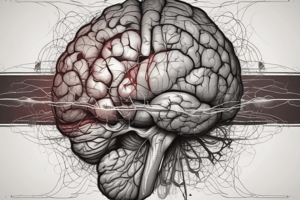Podcast
Questions and Answers
Which type of scalp injury is the most common?
Which type of scalp injury is the most common?
- Firearm injuries
- Bruises or contusions
- Incised wound
- Contused wound (correct)
What is a potential complication of a scalp injury?
What is a potential complication of a scalp injury?
- Severe bleeding
- Intracranial infection
- Tetanus
- All of the above (correct)
What is the defining characteristic of a fissure fracture?
What is the defining characteristic of a fissure fracture?
- A fracture with a sharp, pointed edge
- A linear fracture (correct)
- A localized depressed fracture
- A fracture that is caused by a high momentum impact
Which type of skull fracture is characterized by multiple fracture lines?
Which type of skull fracture is characterized by multiple fracture lines?
What is a signature fracture?
What is a signature fracture?
What is the defining characteristic of a basal skull fracture?
What is the defining characteristic of a basal skull fracture?
What is the cause of cerebral irritation of higher centers in the first phase?
What is the cause of cerebral irritation of higher centers in the first phase?
What is the mechanism of a brain concussion?
What is the mechanism of a brain concussion?
What is the effect of irritation of vasomotor center on blood pressure?
What is the effect of irritation of vasomotor center on blood pressure?
What is the characteristic of pulse in the clinical picture?
What is the characteristic of pulse in the clinical picture?
Which of the following symptoms is NOT typically associated with a brain concussion?
Which of the following symptoms is NOT typically associated with a brain concussion?
What is the effect of depression of respiratory center on respiration?
What is the effect of depression of respiratory center on respiration?
What is the characteristic of temperature in the late stage?
What is the characteristic of temperature in the late stage?
What is the characteristic of pupils in the terminal stage?
What is the characteristic of pupils in the terminal stage?
What is the sequence of muscle signs on the contralateral side?
What is the sequence of muscle signs on the contralateral side?
What is the direction of conjugate deviation of both eyes?
What is the direction of conjugate deviation of both eyes?
What is the definition of a lucid interval?
What is the definition of a lucid interval?
What is the typical cause of a lucid interval?
What is the typical cause of a lucid interval?
What is the medicolegal importance of a lucid interval?
What is the medicolegal importance of a lucid interval?
What is the first stage of cerebral compression?
What is the first stage of cerebral compression?
What is the mechanism of cerebral compression?
What is the mechanism of cerebral compression?
Which reflex is the last to disappear and the first to reappear in a concussion?
Which reflex is the last to disappear and the first to reappear in a concussion?
Which of the following is NOT a potential fate of a cerebral concussion?
Which of the following is NOT a potential fate of a cerebral concussion?
What causes vomiting in a concussion?
What causes vomiting in a concussion?
Flashcards are hidden until you start studying
Study Notes
Scalp Injuries
- Common scalp injuries include bruises, contusions, contused wounds, incised wounds, and firearm injuries.
- Scalp has a rich blood supply, leading to severe bleeding, also can result in intracranial infection and tetanus.
- The leathery texture of the scalp makes it susceptible to significant bleeding when injured.
Skull Injuries
- Types of skull fractures include vault fractures, fissure fractures, comminuted fractures, localized depressed fractures, penetrating fractures, and cut fractures.
- Fractures can be caused by blunt or sharp striking surfaces, with variations in injury severity based on momentum.
- Basal skull fractures can lead to specific types like ring fractures and signature fractures.
Brain Injuries
- Brain injuries encompass contusions, concussions, lacerations, and compression.
Brain Concussion
- Defined as a sudden momentary loss of consciousness caused by head injuries.
- Clinical symptoms include loss of consciousness, low blood pressure, shallow respiration, pale moist skin, equal pupils, vomiting, and flaccid muscles.
- Recovery can be complete or incomplete, or it can involve compression with or without lucidity.
Lucid Interval
- A temporary recovery phase between unconsciousness and compression, allowing patients to function briefly before deterioration.
- Commonly arises from middle meningeal artery injuries and can last from minutes to days.
- Medicolegal relevance exists, as a lucid interval can complicate forensic conclusions about cause of death.
Cerebral Compression
- Defined as increased intracranial pressure affecting brain function, resulting in gradual loss of consciousness.
- Progresses through an irritation phase (cerebral congestion and edema) and a paralysis phase (cerebral ischemia).
- Clinical signs include gradual loss of consciousness, neck rigidity, rising then falling blood pressure, slow pulse, and altered respiratory patterns.
Signs of Lateralization
- Unequal pupils indicate compression severity, with initial constriction followed by dilatation due to paralysis.
- Conjugate eye deviation may occur toward the lesion side before moving to the opposite side.
- Motor function can demonstrate exaggerated reflexes initially, followed by twitches and eventual paralysis, typically starting on the contralateral side.
Studying That Suits You
Use AI to generate personalized quizzes and flashcards to suit your learning preferences.




